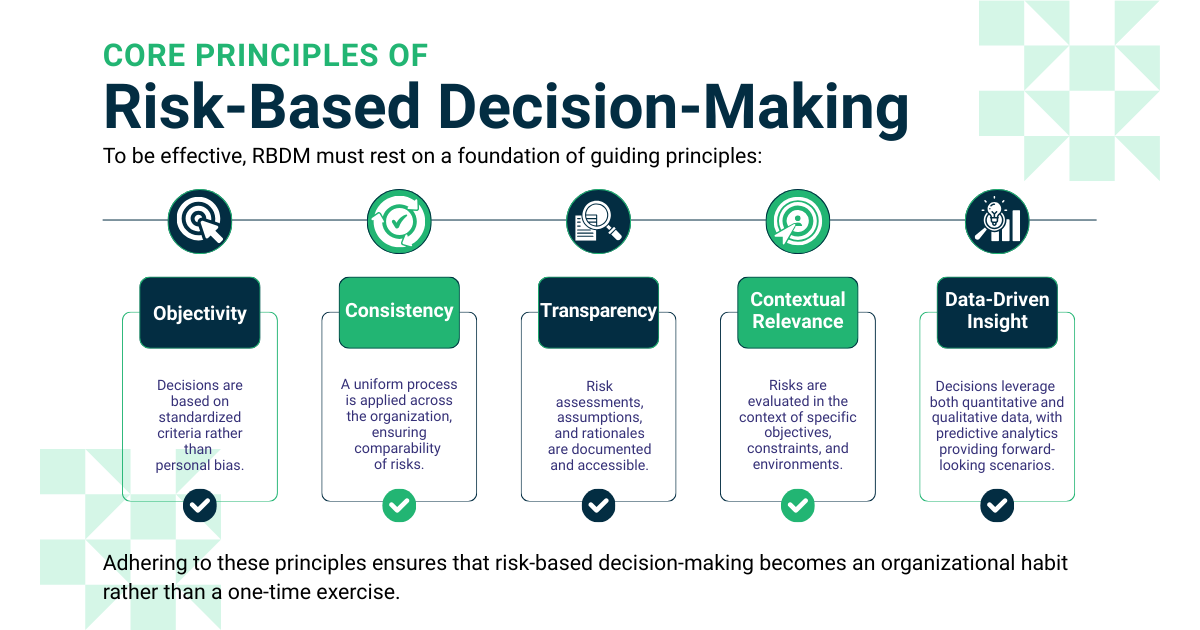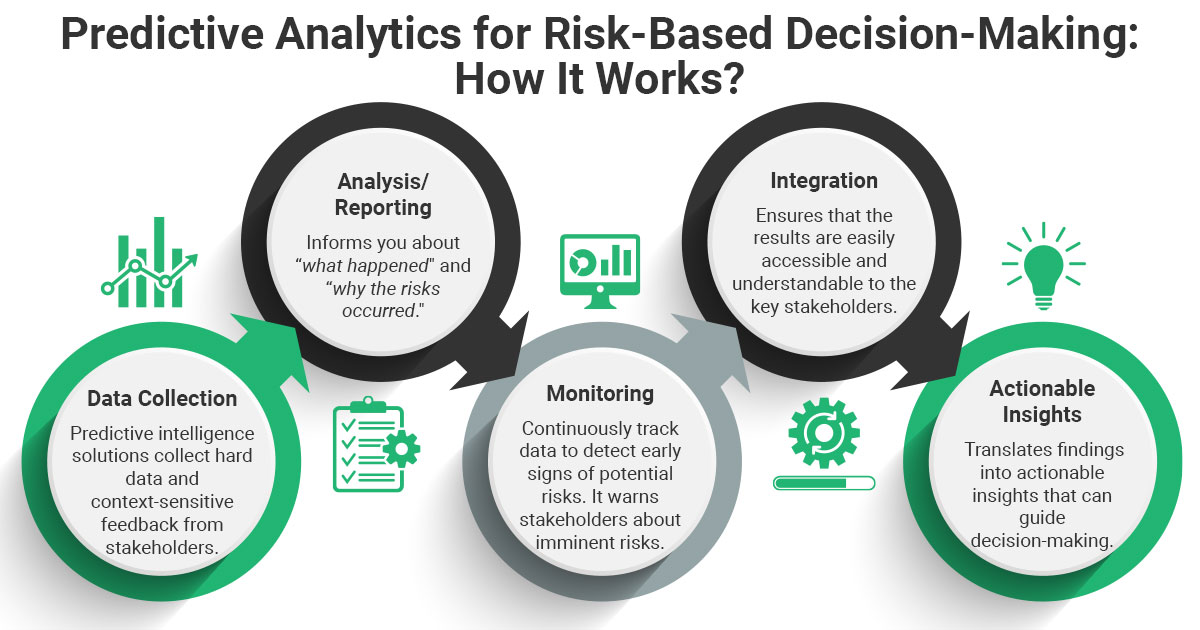
Quick Summary: Most organizations still make critical calls without a structured view of risk, exposing budgets, timelines, and reputations. Risk-based decision-making reframes uncertainty into foresight, equipping leaders with evidence-driven choices that strengthen resilience and sharpen execution. With predictive intelligence, this discipline shifts from defensive risk control to a strategic engine for growth.
How Risk-Based Decision Making Separates Success from Failure
Technological demands are escalating, resources are increasingly strained, and organizational structures are more complex than ever—making risk-based decision-making an essential survival skill for today’s projects. While this approach has long been a cornerstone in high-stakes fields like aviation and healthcare, it is now becoming indispensable across all sectors, especially in project-driven organizations.
The stakes are even higher in aerospace, defense, and advanced research industries. Projects often apply cutting-edge technical expertise at staggering costs—a $75 million initiative may be considered merely “modest.” Here, decisions without proper risk assessment can trigger costly delays, reputational damage, and lost opportunities. At the center of every project stands the project leader, accountable for delivering on project time, within budget, and at the required quality—yet often dependent on people and organizations beyond direct control.
This growing complexity is mirrored in project governance. According to Gartner’s risk-management survey, 43% of respondents acknowledged that IT’s risk-management data has a tangible influence on board-level decision-making. This shift places new demands on Chief Information Officers (CIOs) and IT risk managers to demonstrate clear linkages between IT functions and business risks, ensuring that strategic decisions are informed by accurate risk intelligence.
Modern predictive project management solutions have transformed risk-based decision-making. No longer limited to reactive measures, these solutions introduce real-time visibility, early-warning indicators, and data-driven recommendations. Artificial intelligence-enabled predictive analytics allows leaders to foresee potential challenges weeks in advance and act proactively, turning what was once a defensive safeguard into a strategic advantage.
By integrating predictive intelligence into decision-making, organizations can move beyond managing risk to strategically positioning themselves for success, making every decision more accurate, timely, and aligned with business outcomes.
This article explores the fundamentals of risk-based decision-making, why it’s vital for organizational success, and how predictive intelligence can take it to the next level.
See how TrueProject predicts risks before they hit—combining AI-driven insights with real-time project intelligence to keep you on time, on budget, and ahead of the competition. Discover How.
What Is Risk-Based Decision-Making?
Risk-based decision-making (RBDM) is a structured method that incorporates identifying, evaluating, and managing potential risks into the decision-making process. Rather than concentrating only on the anticipated advantages, it weighs the possible threats and benefits, equipping project and business leaders with a balanced perspective to make well-informed choices.

Unlike conventional decision-making, which relies heavily on experience or intuition, RBDM ensures that every choice is supported by measurable data, documented analysis, and transparent rationale. According to a Project Management Institute (PMI) research study, organizations that fostered a robust risk-management culture witnessed more tremendous project success. After all, projects serve as catalysts for business growth, enabling organizations to adapt, innovate, and thrive in an ever-changing landscape. Additionally, insights from a Harvard Business Review article highlight that companies adopting a decision-making approach grounded in risk assessment are effective at responding to changes.
After understanding risk-based decision-making, the next step is recognizing why it’s indispensable, especially when unforeseen challenges derail even the most well-planned initiatives.

Why Is Risk-Based Decision Making Critical?
In today’s volatile, uncertain, complex, and ambiguous environment, risks can arise suddenly from multiple sources. Supplier delays can disrupt project timelines, budgets spiral due to unplanned expenses, and strategic initiatives can be undermined by changing regulatory requirements. Organizations often react too late without a structured approach to evaluating and mitigating these risks.
The consequences of poor or untimely decisions can be severe:
- Missed revenue targets due to delayed launches.
- Reputational damage from unmet customer expectations.
- Wasted resources on projects that fail to deliver strategic value.
As a core component of integrated risk management, risk-based decision-making equips project and business leaders to make smarter choices while effectively navigating uncertainty. So, what are the benefits of risk-based decisions? Its key benefits include:
- Higher decision quality—Leaders can make strategic, evidence-based choices by following a structured approach to weighing potential risks and rewards. This method fosters clarity and confidence, ensuring decisions are grounded in thorough evaluation.
- Optimized resource allocation—Using risk assessments to guide priorities ensures that critical, high-risk areas receive the necessary focus, while low-risk matters do not drain resources unnecessarily. This targeted approach improves projects’ operational efficiency and goal achievement.
- Stronger operational resilience—Early detection and proactive project risk management enable the creation of contingency plans, faster adaptation to change, and the ability to withstand unexpected challenges.
- Improved compliance and risk control—Risk-based decisions streamline adherence to standards by identifying compliance gaps early in regulated industries. This helps organizations avoid costly penalties and protect their reputations.

If the benefits are so compelling, why do so many organizations still struggle to put risk-based decision-making into practice? The answer lies not in knowing its value, but in mastering a process that turns theory into consistent, high-quality decisions.
The Risk-Based Decision-Making Process
Remember, the real risks are those that you are unaware of. Therefore, the need for risk-based decision-making has never been so pronounced before. While being mindful of potential hazards in your projects or business operations is essential, an overly conservative approach can stifle progress and limit growth. On the other hand, irresponsible decisions can lead to catastrophic consequences. How do you implement risk-based decision-making as a part of your organizational culture rather than just a top-down directive? Here are some steps to follow:
Refine Your Risk Equation: Don’t settle for the conventional “consequences” analysis regarding risk calculations. Refine your approach by considering the following:
- Threats: Identify the threats surrounding your facility.
- Vulnerabilities: Pinpoint potential trouble spots.
- Probability: Gauge the likelihood of problems occurring.
- Consequences: Assess the financial and other costs of potential issues.
- Relevance: Determine the significance in comparison to other identified risks.
Emphasize Quality Data: The strength of your risk assessments is based on the data. Recognize that insufficient or inaccurate data can distort results, often without teams realizing it. The predictive project management solution can help analyze vast datasets and reveal hidden or emerging risks that may not be immediately apparent.
Harness Internal and External Expertise: While internal teams provide valuable institutional knowledge, external experts bring industry-wide perspectives gained from diverse enterprises. Additionally, you can integrate AI-powered predictive analytics for accurate project insights, as these models pinpoint areas most susceptible to disruption, allowing for proactive mitigation strategies.

Embrace Constructive Feedback: Holistic risk assessments thrive when everyone collaborates to mitigate risks, even if it means acknowledging that the current approach may not be optimal. Open team communication encourages fresh perspectives on familiar situations, unveiling previously unnoticed hazards.
Include Project Risk Management Processes: Another concrete step is to include risk considerations in your project management processes. Integrating RBDM into project management enhances decision quality at every stage:
- Initiation: Evaluate project feasibility using risk-adjusted scoring and predictive forecasts.
- Planning: Allocate resources based on forecasted demand and risk impact analysis.
- Execution: Monitor real-time performance indicators to detect early signs of deviation.
- Monitoring & Controlling: Use predictive alerts to address issues before they affect delivery.
- Closure: Document risk-related lessons learned to improve future decisions.
Example: In a software project, predictive analytics may reveal a trend in requirements changes that, if unchecked, could push delivery timelines by six weeks. Acting on this insight early allows leaders to stabilize scope and protect deadlines.
Commit to Action: Contrary to the misconception that assessments mark the end of the road, the real work begins afterward. While there may be valid reasons not to pursue specific recommendations, as a CIO or a project leader, you must resist defaulting to opting out. Balancing risks and consequences in assessments streamlines your risk-based decision-making, but the ultimate goal is to enable more informed choices.
Even with a transparent process, real-world execution isn’t without obstacles. From elusive risks to shifting priorities, the path can get complicated, making it essential to know the challenges ahead and how to turn them into opportunities.
Don’t just manage risks, stay ahead of them. See how TrueProject’s predictive intelligence empowers leaders to make faster, sharper, and impact-driven decisions. Schedule Your Demo.
The Common Challenges of Risk-Based Decision-Making and Solutions to Overcome Them
While risk-based decision-making delivers clear advantages, organizations often encounter hurdles during implementation. A predictive project management solution can address these obstacles by providing real-time insights, advanced analytics, and proactive alerts that keep risks visible and manageable.
1. Unclear Risk Identification: Without a defined process or reliable data, critical threats may be overlooked or underestimated.
Solution: Establish a structured risk identification framework supported by predictive project management tools. These solutions consolidate data from multiple sources, apply advanced analytics to identify hidden risks, and provide early warnings before project issues escalate. Involving cross-functional teams ensures diverse risk perspectives are captured.
2. Difficulty Prioritizing Risks: Knowing which risks to tackle in complex environments can be challenging, leading to resource misallocation.
Solution: Apply prioritization models such as risk matrices or scoring systems to rank threats by likelihood and impact. Visual tools like project dashboards or heat maps simplify analysis and improve clarity.

3. Resistance to Change: Shifting to a risk-based approach can face pushback from leadership or teams accustomed to traditional methods.
Solution: Leverage predictive project management solutions to demonstrate quick wins through data-backed insights. The platform makes risk analysis more intuitive, enabling stakeholders to see the approach's tangible benefits. Pair this with training, pilot projects, and leadership advocacy to secure buy-in.
4. Weak Data Management: Fragmented or outdated systems make it difficult to compile accurate, up-to-date information for decision-making.
Solution: A predictive project management platform centralizes project and risk data into a single, integrated system. Automated updates, data validation, and historical trend tracking ensure accuracy, while real-time access supports faster, more reliable decisions.
5. Adapting to Evolving Risks: Risks shift quickly, and delayed responses can leave organizations vulnerable.
Solution: Predictive tools continuously monitor risk indicators, sending proactive alerts when conditions change. Scenario modeling capabilities allow leaders to test potential responses before committing to an action, ensuring strategies remain agile and effective.
Overcoming these challenges is just the beginning. What if you could go a step further and spot risks before they appear on the horizon? That’s where predictive analytics changes the game for risk-based decision-making.
Is Predictive Analytics the Future of Risk-Based Decision-Making?
By implementing predictive analytics, project leaders can more accurately detect and evaluate possible risks, create and implement efficient risk-reduction plans, and ultimately make better decisions.
Predictive risk assessment analytics leverages internal and external data to effectively pinpoint, evaluate, and mitigate potential risks. By employing historical data, predictive models adeptly identify patterns and trends, translating them into valuable insights for anticipating future outcomes. The advantages of incorporating predictive analytics into risk management practices are manifold:

Enhanced Risk Identification and Assessment: Predictive models significantly boost the precision and efficiency of identifying and assessing risks compared to traditional methods. The strength lies in predictive analytics' capability to sift through extensive datasets, uncovering intricate patterns and trends that manual approaches might find challenging or impossible.
Early Warning Signals: Predictive data provides early warning signals of potential risks. You can leverage this foresight to proactively implement necessary actions, preventing the risks from materializing and causing any detrimental impacts on your business or project initiatives.
Informed Decision-Making: Predictive insights contribute to a more comprehensive understanding of potential outcomes. This broader vision equips you with valuable information, enabling you to make informed choices based on a nuanced understanding of possible risks and their implications.
Using predictive analytics for risk-based decision-making streamlines the identification and assessment processes. It empowers you with the foresight to take proactive measures, fostering a culture of informed and preventive decision-making.

Beyond Defense: Transforming Risk Management into Strategic Execution
The reality is simple: risk will never disappear, but how you respond defines whether your projects stall or succeed. Risk-based decision-making isn’t about avoiding uncertainty but turning uncertainty into foresight, structure, and action. The organizations that win aren’t those with the fewest risks, but those with the clearest line of sight—weeks ahead, not days behind. Equip your leaders with real-time risk intelligence, normalize challenge-seeking conversations, and let data—not optimism—decide priority. That’s how budgets hold, timelines stay honest, and credibility compounds.
When you add predictive intelligence into the mix, risk-based decision-making turns from a box to tick into real momentum. It’s about combining complex numbers with the people-side of projects, spotting the early signs before they spiral, and acting while there’s still room to choose your path. When you do this consistently, this approach takes risk management out of a defensive corner. It turns it into a driver of success—where decisions are quicker and sharper and connected to results the business can see and trust.
This is precisely where TrueProject, a predictive intelligence solution for project health and performance, makes a difference. By fusing AI-driven predictive analytics with real-time project intelligence, TrueProject gives project and business leaders early warning signals, a 360° view of project health, and risk-scored insights they can trust. It connects the dots across people, processes, and systems—revealing hidden risks, prioritizing what truly matters, and equipping decision-makers to act before issues escalate. With TrueProject, risk-based decision-making becomes more than a process; it becomes the engine of consistent, on-time, on-budget, and high-quality delivery.
Effectively incorporating predictive analytics into your risk-based decision-making approach safeguards your organization against potential pitfalls. It propels the business toward a future of sustainable growth and resilience.
Turn uncertainty into confidence. See how TrueProject’s QuickStart program delivers instant predictive insights, real-time risk signals, and measurable project success from day one. Start Now.
FAQs for Risk-Based Decision-Making
1. What is risk-based decision-making in project management?
Risk-based decision-making in project management involves evaluating project risks—such as cost overruns, schedule delays, or resource gaps—before making critical decisions. It ensures that project choices are aligned with organizational objectives and risk tolerance.
2. Why is a risk-based approach critical in projects?
It helps project leaders anticipate challenges, allocate resources effectively, and avoid costly failures. By assessing risks early, organizations minimize surprises and improve project success rates.
3. How do project managers implement risk-based decision-making?
Project managers integrate risk assessments into each phase—initiation, planning, execution, monitoring, and closing. They use risk registers, thresholds, and predictive tools to guide decisions.
4. What tools support risk-based decision-making in projects?
Predictive project management solutions like TrueProject enhance RBDM by providing early-warning signals, KPI monitoring, and scenario modeling to inform better project decisions.
5. How does risk-based decision-making improve project outcomes?
It reduces project overruns, improves stakeholder trust, and ensures resources are focused on high-value, low-risk initiatives. Projects are delivered on time, within scope, and at optimal quality.
6. What are common mistakes in applying RBDM to projects?
Common pitfalls include relying on outdated data, inconsistent team application, and failure to act on identified risks. Standardized processes and predictive intelligence mitigate these challenges.






